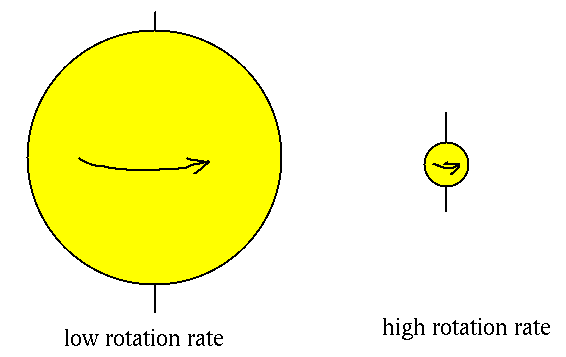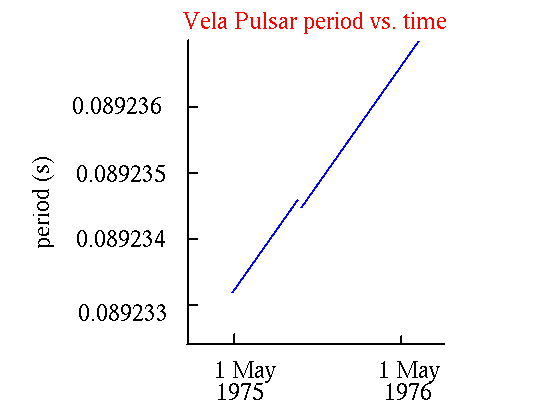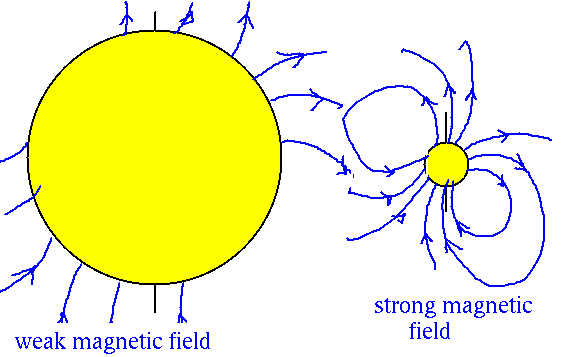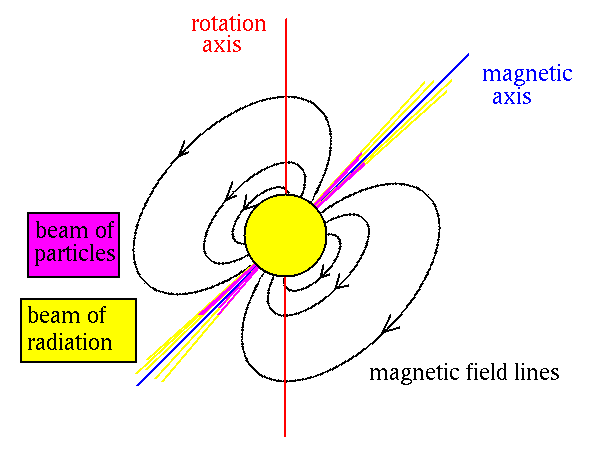Neutron Stars
Recall that one of the possible
endpoints of stellar evolution is a neutron star. Furthermore,
there is evidence for the
existence of a neutron star.
Why should one think that pulsars are neutron stars?
- Individual pulses are rather messy.
- --> Evidence for a complicated mechanism.
- Pulses repeat at very regular intervals.
- --> Evidence for a very good clock.
- What is the clock?
- Rotation seems a sensible guess.
- The only possible guess?
- Assuming that the clock is rotation, what is the object?
- periods range from 4 s to 1.6 ms = 1.6 x 10-3 s.
- These fastest ones are called ``millisecond pulsars.''
- The surface of the the pulsar can't be moving any faster than
the speed of light.
- Therefore the radius must be less than
2 Pi R = (speed of light) x (period)
R = (speed of light) x (period) / (2 Pi)
R = (3 x 108 m/s) x (1.6 x 10-3 s)/(2 x 3.14)
R = 8 x 104 m = 80 km.
- With a size less than 80 km, it is too small to be a white dwarf.
- Black holes don't really have surfaces that could be rotating.
- This leaves neutron stars as the only possibility.
Are neutron stars left behind by supernovae?
Also recall that, at least theoretically, a type II supernova explosion
leaves a massive core of neutrons behind. Let's
look at this..
Why should a neutron star be rotating so fast?
As the stellar core shrinks, it must rotate faster in order to
conserve its angular momentum.

- A rotating object has energy stored in its rotation.
- The faster the rotation, the more energy.
- The pulsar is losing energy
- it radiates energy away that we see in the pulsations.
- the Crab pulsar lights up the whole Crab Nebula
- Therefore it should be slowing down.
- Careful measurements show that pulsars are very gradually slowing down.

Neutron stars should also have big magnetic fields
Recall that electrically conducting fluids tend to trap magnetic
field lines. The fluids can move across the field lines only very
slowly, and conversely the field lines can move across the fluid
only very slowly. (Cf. the reason why sunspots are dark.)
So what happens when an electrically conducting sphere collapses
to a much smaller size?

The magnetic field lines get concentrated in a smaller surface area,
so the magnetic field is stronger.
Note: keeping the magnetic field requires an electrically conducting
star. Neutrons are electrically neutral, but the theory of neutron
stars suggests that there are enough protons and electrons in the
star to provide the conductivity -- in fact super good conductivity.
Some evidence for strong magnetic fields associated with neutron stars:
the white light produced by the Crab Nebula appears to be the sort of
light made when electrons move along cureved paths through a strong
magnetic field.
Lighthouse model for the pulses
A model for how the pulses are produced:

- The neutron star has a strong magnetic field frozen into it.
- The field rotates with the star.
- Energetic charged particles can escape along the field lines
at the north and south poles.
- The particles make radio waves when they get away.
Starquakes
The glitch in the period vs time graph above is an example of a
phenomenon that is observed in other pulsars too. It appears
that neutron stars have a (thin) solid surface that can break suddenly
in a ``starquake.'' Then the star gets a little smaller and its
rotation rate speeds up accordingly.
Millisecond pulsars
Some pulsars with periods of just a few milliseconds have been found.
- Are these newly formed pulsars, that haven't had time to lose
energy and slow down?
- No, because many are found in globular clusters, which are very
old.
- Neutron stars come from the death of big stars.
- Big stars die soon after they are born.
- Thus these stars must have gotten more angular momentum recently.
- The favored explanation is that they got the angular momentum
from a companion star.

Davison E. Soper, Institute of Theoretical Science,
University of Oregon, Eugene OR 97403 USA
soper@bovine.uoregon.edu





